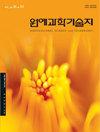垦地原水中不同NaCl浓度培养基水培甜椒和番茄的生长特性
IF 0.8
4区 农林科学
Q3 HORTICULTURE
Korean Journal of Horticultural Science & Technology
Pub Date : 2023-04-30
DOI:10.7235/hort.20230016
引用次数: 0
摘要
复垦土地作为耕地,可以通过大规模的控制环境农业改善粮食自给率低或出口竞争力。然而,在作物种植过程中,复垦土地的高盐度会引起疾病并降低产量。本试验旨在了解在岩棉和椰胶培养基中水培甜椒和番茄的生长特性,反映复垦地原水电导率(EC)和NaCl浓度的变化。对于甜椒,麻茶品种(C. annuum L. cv。都被使用了。番茄方面,tytrust品种(S. lycopersicum L. cv;使用了TY TRUST)。在营养液中添加NaCl,每周1次,以EC为基础组成处理组。甜椒和番茄的NaCl处理水平为:无(CON)、EC 4.0 (T1)、EC 4.5 (T2)、EC 5.0 (T3)和EC 5.5 dS·m-1 (T4)。以甜椒和番茄的株高、叶面积、叶鲜重、叶干重、茎鲜重、茎干重和果实产量作为作物生长特性的指标进行了研究。甜椒的生长指数随NaCl浓度的增加而降低,与培养基类型无关。在本研究中,NaCl浓度对甜椒产量的影响不显著,使用椰胶培养基可以保证甜椒产量。然而,与对照组相比,施用NaCl处理后番茄的叶面积显著减少。NaCl浓度高于T2时,其他大部分生长指标均显著降低。用椰胶培养基代替岩棉培养基培养番茄,降低了NaCl浓度的影响。因此,对于水培栽培的甜椒和西红柿,如果提供含有NaCl的原水,如果使用椰油培养基,可能会保持作物产量。本文章由计算机程序翻译,如有差异,请以英文原文为准。
Growth Characteristics of Bell Pepper and Tomato Hydroponically Cultivated in Growth Media Containing Different NaCl Concentrations in Raw Water on Reclaimed Lands
Reclaimed land used as arable land can improve low food self-sufficiency or export competitiveness through large-scale controlled-environment agriculture. However, high salinity in reclaimed land can cause diseases and decrease yields during crop cultivation. This study was conducted to understand the growth characteristics of bell pepper and tomato hydroponically cultivated in rockwool and coir media reflecting changes in electrical conductivity (EC) and NaCl concentrations in the raw water of reclaimed lands. For bell pepper, Machai varieties (C. annuum L. cv. Machai) were used. For tomatoes, TY TRUST varieties (S. lycopersicum L. cv. TY TRUST) were used. NaCl was supplemented into the nutrient solution once a week to construct a treatment group based on EC. For bell pepper and tomato, NaCl was supplied at the following levels: none (CON), EC 4.0 (T1), EC 4.5 (T2), EC 5.0 (T3), and EC 5.5 dS·m-1 (T4). The plant height, leaf area, leaf fresh weight, leaf dry weight, stem fresh weight, stem dry weight, and fruit yield of bell pepper and tomato were investigated as indicators of growth characteristics of crops. For bell peppers, the growth index decreased with an increase in the stage as the NaCl concentration was increased, regardless of the type of media used. The use of coir media could secure bell pepper production yields without a significant effect of the NaCl concentration at the levels used in this study. However, for tomatoes, the leaf area was significantly decreased when NaCl concentrations were applied compared to that of the control group. Also, most other growth indicators were significantly decreased at NaCl concentrations above T2. The effects of the NaCl concentration were reduced when tomatoes were cultivated in coir media instead of rockwool media. Therefore, for hydroponically cultivated bell peppers and tomatoes, if raw water containing NaCl is supplied, it may be possible to maintain the crop yield if coir media are used.
求助全文
通过发布文献求助,成功后即可免费获取论文全文。
去求助
来源期刊
CiteScore
2.00
自引率
0.00%
发文量
0
审稿时长
1 months
期刊介绍:
Horticultural Science and Technology (abbr. Hortic. Sci. Technol., herein ‘HST’; ISSN, 1226-8763), one of the two official journals of the Korean Society for Horticultural Science (KSHS), was launched in 1998 to provides scientific and professional publication on technology and sciences of horticultural area. As an international journal, HST is published in English and Korean, bimonthly on the last day of even number months, and indexed in ‘SCIE’, ‘SCOPUS’ and ‘CABI’. The HST is devoted for the publication of technical and academic papers and review articles on such arears as cultivation physiology, protected horticulture, postharvest technology, genetics and breeding, tissue culture and biotechnology, and other related to vegetables, fruit, ornamental, and herbal plants.

 求助内容:
求助内容: 应助结果提醒方式:
应助结果提醒方式:


